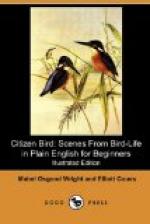“To keep it warm, too, I guess,” was Rap’s answer.
“Well, you are all three partly, but not quite, right. Certainly the beauty of a bird depends most on its feathers, being not even skin-deep, as you may well believe, if you ever noticed a chicken Mammy Bun had plucked. But, Nat, how can feathers make a bird lighter, when every one of them weighs something, and a bird has to carry them all? They make a bird a little heavier than it would be without them. Yet it is quite true that no bird could fly if you clipped its wings. So some of its feathers enable it to fly—the large ones, that grow on the wings. Then, too, the large ones that make the tail help the bird to fly, by acting like a rudder to steer with. Perhaps the small ones too, all over the body, are of some help in flight, because they make a bird smooth, so that it can cut through the air more easily—you know they all lie one way, pointing backward from their roots to their tips. Then when Rap said feathers keep a bird warm, he guessed right. Birds wear plumage as you do clothes, and for the same purpose—to look nice and keep warm.”
“But what is ‘plumage,’ Uncle Roy?” asked Dodo; “I thought you were talking about feathers.”
“So I was, missy. Feathers are the plumage, when you take them all together. But see here,” added the Doctor, as he spread the Sparrow’s wings out, and held them where the children could look closely; “are the wings all plumage, or is there something else?”
“Of course there’s something else to wings,” said Dodo; “meat and bones, because I’ve eaten chickens’ wings.”
“Why didn’t you say, Dodo, because there has to be something for the feathers to stick into?” said Nat decidedly.
“You both have very good reasons,” said the Doctor. “The plumage of the wings grows out from the skin, just as feathers grow from any other part of the body, only the large ones are fastened to the bones, so that they stay tight in their proper places. If they were loose, they would fly up when the bird beats the air with its wings, and get out of order. See how smoothly they lie one over another! When the bird closes its wings, they come together snugly along its sides. But when the wing is spread, they slide apart—yet not too far to form a broad, flat surface, quite stiff, but light and elastic. By beating the air with the wings birds fly along. It is something like rowing a boat. This surface pushes against the air as the flat blade of an oar pushes against the water. That is why these large stiff feathers are called the rowers. When the Wise Men talk Latin among themselves, they say remiges, for ‘remiges’ means rowers.”
“But, Doctor,” said Rap, who was looking sharply at the Sparrow’s wing, “all the feathers are not like that. Here are a lot of little ones, in rows on top of the wing in front, and more like them underneath, covering over the roots of the rowing feathers. Have they any name?”




